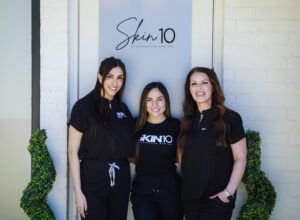Horse power – The joy of riding, owning and showing keeps local equestrians passionate about the sport
Like a lot of young girls, Lindsey Weinstein became enamored with horses while still a toddler. She celebrated her second and third birthdays with pony parties at Kleinpeter Farms, and by the time she could read she had her sights set on a pony of her own.
Over the past decade, Lindsey’s preschool preoccupation has evolved into an equine obsession that involves riding and showing her Welsh Pony, Buckle Up. For Lindsey, 12, and others like her, riding is not only a pastime but a passion that has taken her around the country, helped forge friendships, and opened her eyes to a special world that only a relatively few are able to enjoy.
“I just love the animals,” says the Episcopal School seventh-grader, explaining what has drawn her to horses. “People say riding is not a team sport. Well, that’s not true. My horse and I are a team.”
What attracts someone to horses? More specifically, what motivates them to ride and show, or compete, on their horses in one of the disciplines within the English-style of riding, which include hunter, jumper, and dressage, among others?
The answers vary, but those who spend countless hours a week—and tens or even hundreds of thousands of dollars a year—training, riding and showing horses say their enthusiasm for what they do comes from deep within them. It begins with something innate: You either love horses or you don’t. There’s not a lot of in-between.
“It’s really a lifestyle,” says Tara Weinstein, Lindsey’s mom, who grew up around horses in her native New Iberia. “Once you start doing it, you devote so much time to it, it really becomes part of who you are.”
For Brittany DeSalvo, riding and showing horses is not only a lifestyle but also her life’s work. The local trainer keeps 20 horses and ponies for clients at Sommerview Farms, her lush, 10-acre property on the winding, scenic Bayou Paul Road in St. Gabriel.
“I love it,” says DeSalvo, who, as a 15-year-old in 1999, won the Small Junior Hunter division at the National Horse Show in Madison Square Garden. “I love the blood, the sweat and the tears. When you finish a round of competing with an animal and you have perfected it, there is no better feeling in the world.”
Like Lindsey Weinstein, DeSalvo wasn’t long out of diapers when she developed a thing for horses, thanks to Hasbro’s line of lovable pastel My Little Pony toys and accessories. By the time she started elementary school at The Dunham School, she’d graduated to riding real horses at a BREC summer camp. When she turned 8, her parents bought her a quarter horse of her own, which she soon began showing.
At 29, DeSalvo still rides and shows. However, she spends most of her time teaching others how to master the various competitive categories that fall under the umbrella of English-style riding, which is a forward-seat riding style that differs from the more casual Western style.
One of the most popular categories among local competitive riders is the hunter style, which, as its name suggests, is modeled after the traditional English fox hunting–style of riding. Riders are judged on the way they handle the horse as it does various jumps and maneuvers. Style and precision are very important, not only in the movements of the horse but also in the manner of the rider—even down to her traditional equestrian riding attire.
Jumper style, which is often combined with hunter, focuses more on the speed and height of a horse’s jumps. Show jumping includes fences and sharp turns and involves somewhat more athleticism than show hunter competitions.
Another popular show category is dressage. It involves a series of carefully choreographed, predetermined movements that horse and rider perform together. Some compare it to a dance.
DeSalvo and most of her clients do hunters, jumpers or both. Most, though not all, are teenage or pre-teen girls. Their numbers, she says, are growing.
“It’s a much bigger sport than when I was growing up,” she says. “We used to have to go to Texas to find someone to really work with me. Now there are at least seven or more qualified trainers in the Baton Rouge area.”
Dr. Chet Kleinpeter, one of the area’s best-known equine veterinarians, has also seen an increase in riding and showing among Capital Region residents. Perhaps more interesting, he has noted in his clients an increased sophistication concerning their animals.
“What we are seeing is a trend toward clients who have fewer horses but choose to take extraordinarily good care of them,” he says. “Instead of having nine or 10 horses, clients might have one or two, and they’re more selective and careful about them.”
That may be due, in part, to the expense of buying and owning a horse. Though horses can be found for as relatively inexpensively as $5,000, a good warmblood show horse will average around $30,000 and can easily cost much more. A Welsh Pony, meanwhile, which is a small breed of horse popular with youth riders because it is easy to train and control, can cost upwards of six figures.
That’s just for starters. Once you own a horse, you need a good trainer to keep it and care for it, unless you have stables of your own. Monthly costs for board, food, grooming and training can run between $500 and $1,000. Then there are the clothes, which at the minimum include breeches, jodhpurs, chaps and boots, not to mention pricey, proper show coats, shirts, helmets and gloves, among other accessories, for those in the competitive arena.
Because riding and showing involves so many expenses, it tends to attract a well-heeled crowd. DeSalvo remembers competing in horse shows against daughters of national figures such as TV host Joan Lunden, rock star John Cougar Mellencamp and New York Mayor Michael Bloomberg. But celebrity sightings aside, DeSalvo maintains that those who stick with and end up excelling at the sport do it because they have an affinity for the animals, not to impress.
“Really, there is nothing glamorous about it,” says DeSalvo. “It takes guts. You spend hours on the road. You do it because you love it. And if you love it, there is no better feeling in the world.”
Millicent Dittmar knows that feeling. The local attorney and mother of two met her husband, Edward, when they were both 20-year-old horseback-riding counselors at camps Mondamin and Green Cove in North Carolina. She had grown up riding in the Baton Rouge area; he had done the same in his native Dallas. Today, their daughters Wellesley, 15, a freshman at St. Joseph’s Academy, and Amelia, 12, a sixth-grader at St. Aloysius School, both ride and compete, as does Millicent.
The family is quite accomplished. At least four days a week after school, the Dittmar girls ride at Sunfox Farm, the Gonzales stables where they keep their horses with owner/trainer Ashley Glisson. Millicent rides almost every day. On weekends, they show—and win. In 2011 Amelia and her horse won the state competition in the Pony of the Year category. Millicent won in the Adult Amateur division. Wellesley placed in her category.
“It’s a way of life for us,” Millicent says. “When Edward and I got married, he joked that he knew a horse was a part of the deal.”
It kind of was. The couple had their first horse, a paint named Liza, before they had their first child. Liza’s son, D.W., is still with the family and is now the horse Wellesley rides.
“We have been very blessed,” Millicent says. “For us it’s a family thing. It’s just something we all do together.”
Others agree that one of the biggest draws with riding and showing is the bonding—not only with family members but also with friends. Because competitive circles are relatively small and close-knit, riders get to know one another, particularly in a state like Louisiana.
“We’ve made friends from all over the Baton Rouge, New Orleans and St. Tammany area,” says Amy Phillips, whose 14-year-old daughter, Lindsey, an eighth-grader at St. Aloysius, excels in the jumpers category. Lindsey’s horse, Solitaire, was bred from a renowned Grand Prix show jumper, Voltaire. “It’s been a wonderful way for Lindsey and me to bond.”
Lindsey Weinstein’s mother, Tara, agrees that one of the greatest results from her daughter’s passion for riding and showing is that it has brought them closer together: an effect all the more notable in that seventh-grade Lindsey is at an age when many girls try to distance themselves from parents.
“It’s also so good for young girls to be outside and with animals and with other girls their own age from different parts of the country,” Tara says. “It’s great for them to be away from iPhones and computers. It’s a graceful, beautiful thing to do.”











